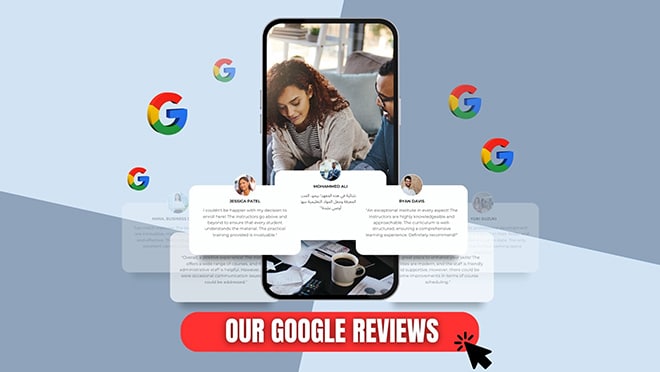Search for your desired courses here
Report Writing Skills
Report writing skills training course 1: The Course on Business Writing, Technical Documents and How to Write Clearly for Maximum Impact.
Overview of the course:
The report writing skills course contains a variety of detailed sessions, each focusing on different aspects of this life cycle. The ability to communicate is an important skill. Much of today’s interpersonal communication takes place through writing. Targeted, concise and persuasive text can make all the difference when convincing someone of your ideas, services, or products. Achieving results through proposals, reports, technical texts, emails, memos, etc., depends on your ability to successfully persuade your readers and help them understand and act on your ideas. This comprehensive course focuses on all aspects of writing business texts, documents, reports, etc., used regularly in most jobs and professions. It covers the entire life cycle of writing, from understanding the audience, collecting material, planning the structure, organizing, writing, styling, presentation, and the general strategy required to make the text more convincing and targeted.
Each session provides step-by-step guidelines on approaching the subject and is followed by exercises where delegates can immediately practice the skill. Research shows that the best way to learn is by example. All sessions contain specific examples showing precisely how recommended guidelines can be implemented. Examples of good & bad text are carefully constructed to show what works & what doesn’t, so delegates can quickly apply those guidelines while participating in training exercises & later to real-world scenarios.
Learning Outcome
- Setup your report writing strategy based on established principles, your Audience and your preferred style
- Structure your report systematically using an efficient and established Logical layout
- Appeal to readers using direct and indirect approaches and convince them of your cause
- Use powerful tools to significantly increase your creativity while putting your Content together to prepare a report
- Present your report with appropriate styles to achieve maximum impact Without causing distraction
- Deliver your content using clear and effective language that is easy to read, understand and act on Program Content
- Use a high-impact and clear writing style that delivers your true meaning as
quickly and effortlessly as possible - Write a condensed yet effective summary of your report that highlights the importance of your report and encourages further reading.
- Write titles that excite your readers about your content and encourage them to read the rest of your report.
- Phrase your sentences efficiently to persuade others to your product or idea.
Who needs the Program?
Report writing skills training aims to make writing easier for delegates by helping them focus on these smaller tasks individually and master them. The collection of these skills would then allow the delegate to write any text of any length with ease while increasing its Impact and persuasiveness. Examples, particularly bad examples, are a great source to help people understand what works and how specific techniques are used in practice.
Report writing skills training Detailed Course Content.
In this highly practical course delegates will learn
REPORT WRITING STRATEGY
- How people read and what are the implications for an author?
- What do you need to consider before writing?
- What is the ideal structure of a technical writing or report?
- How to think of your purpose to make your writing activity easier?
- What is the ideal tense to use in report writing?
- When should you write in first-person, second-person or third-person?
PERSUADING READERS
- What are the common persuasion tactics employed by authors?
- What are the differences between direct and indirect approaches to persuasion?
- When should you go for global view in contrast with the details?
- When should you explain complex content in contrast with simple content?
- How to sequence your content based on common dimensions, such as urgency, importance and chronology?
COLLECTING AND ORGANISING CONTENT
- What is the most effective way to prepare content for writing reports?
- How to exploit the visual power of your brain through mind maps and organise your content?
- How to increase your creativity using simple yet powerful tools and techniques?
STYLING AND PRESENTATION
- How to use headings?
- How to increase the visual impact of your presentation to get maximum effect?
- How to use tables, graphs, bullet points, margins, etc. to enhance your message?
- What are the most effective styles such as fonts, font sizes, effects, paginations and line spacing?
- How to use these styles to make your message clearer, without distracting the reader through overuse of these effects?
INCREASING THE IMPACT THROUGH LANGUAGE
- How to deliver your message as quickly and clearly as possible?
- What are the common techniques employed by professional writers in delivering an engaging text?
- How to make your message viral?
- How to avoid vague writing that can lead to misunderstanding?
- How to use technical terms to serve your message?
- What is an ideal tone to convince a reader and keep him engaged?
- How to sequence your statements to make them more convincing?
USING CLEAR ENGLISH
- How to increase the clarity of your English using simpler sentence structures?
- How to use action verbs?
- How to warm up the reader before explaining potentially complex topics?
HIGH IMPACT SUMMARIES
- How to structure executive summaries?
- How to plan summaries to get best results?
- Which areas need more focus and are read more frequently?
WRITING TITLES THAT GRAB ATTENTION
- How to use proven formulas used by mass media to create engaging titles?
- How to create catchy or descriptive headlines?
SELLING YOUR IDEAS
- How to write to sell?
- How to structure your text to convince your audience of your cause?
- How to appeal to emotions?
Report writing skills training course 2: Writing Convincing Proposal
Learning Outcome:
- Explain the key difference between reports and proposals.
- Identify the six essential questions that you must answer before beginning any proposal.
- Explain the importance of establishing your credibility with your readers.
- Explain the importance of presenting a proposal that solves a problem for your readers.
- Write a covering letter that quickly establishes context for the attached proposal.
- Construct a title that includes your major recommendation and benefit.
- Write an executive summary that includes the problem, the consequences, your solution, benefits for the reader and a call to action.
- Write a background section that provides the necessary context so that readers will understand and appreciate the solution you’re proposing and the benefits that it brings.
- Explain the importance of including a section early in the document that clearly sets out the details of the solution you’re proposing and does so in plain language.
- Distinguish between features, advantages and benefits, and convert features and advantages to benefits.
- Include cost information in a format that is accessible to both accountants and non-accountants.
- Employ a modular format that easily enables you to add additional sections, as needed, on such topics as risks, schedules, training, equipment and legal issues.
- Employ plain English to enhance your clarity and reputation.
- Employ highly effective persuasion strategies suggested by research in the field of social psychology.
- Engage in effective lobbying behavior that predisposes your readers to be amendable to your written proposal.
Detailed Course Content
1. Proposals are not reports 1
- How are reports and proposals different?
- A review of the essential report-writing questions
2. Phase 1: Decisions and preparations
- Overview: seven key questions you must answer
- What’s my goal?
- Current situation: What problem or opportunity are my readers faced with?
- Deliverables: What results will I deliver?
- Solution: How will I deliver these results?
- Experience: Why should my readers believe that I can deliver these results?
- Costs: How can I justify the cost of these results?
- Benefits: Why should my readers want these results?
- Summary of the pre-writing process
3. Phase 2: Assembling the proposal
- Covering letter
- Title page
- Executive summary
- Table of contents
- Glossary of terms
- Background
- Results and solution
- Experience
- Cost summary
- Financial details
- Benefits
- Risks assessment weaknesses
- Optional components
4. Plain English
- What is plain English?
- Key 1: Impress them with simplicity
- Key 2: Impress them with brevity
- Key 3: Impress them with your style
- Chapter summary
5. The politics of persuasion
- The six tendencies that lead to ‘yes’
- Reciprocity
- Consistency
- Social validation
- Being liked
- Authority
- Scarcity
To see our Google Reviews







